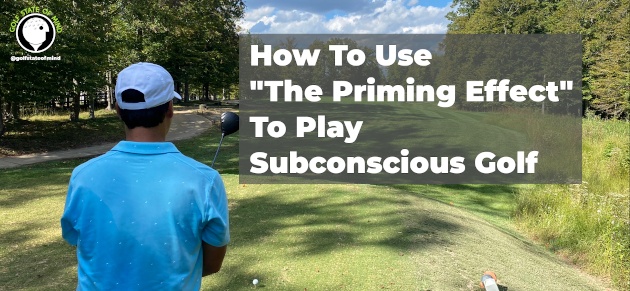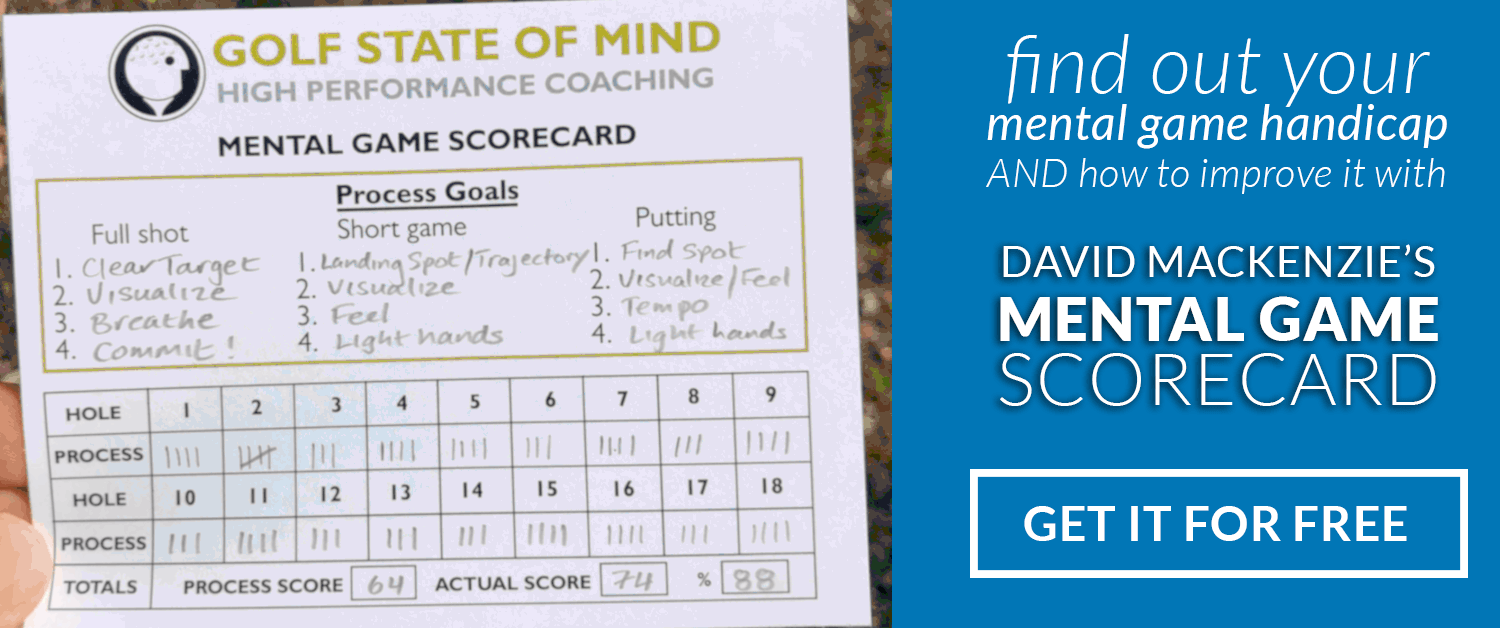
Using The Priming Effect To Play Subconscious Golf
If I was to ask you what “thinking” is, you might refer to it as activating your brain to solve a problem or to “think through” something. However, as much as we like to think we have control over our thinking, most of it is automatic or “subconscious”. How we think and feel in certain situations is mostly predetermined by our “thinking patterns” and recent memories.
In fact, neuroscientists say that up to 95% of our mental and physiological processes happen without us being aware of them happening.
This is actually a good thing. As I’m sure you’ve experienced, your best golf is when you are playing with little thought – you are playing subconscious golf. That said, playing subconscious golf is not much good if what’s in your subconscious is negative and creates feelings of fear and worry.
In this article, I’m going to share some powerful techniques for “priming” your subconscious daily and during your rounds to create a feeling of confidence and give you access to your best skills under pressure.
The Two Minds
In his book “Thinking Fast and Slow”, psychologist and Nobel Prize winner (in Economics), Daniel Kahneman explains that most of our decisions are made using what he calls “System 1” the automatic, intuitive mind.
The logical and analytical mind, which he calls “System 2” is used very little in comparison. The reason that System 1 is used to do the majority of our “thinking” is about energy efficiency – it is faster and uses less energy to operate than System 2.
In the context of a golf shot, you make decisions on the best shot to play using your System 2, but the faster, more intuitive System 1 will be used to play the shot, and it’s best to leave it to do so with minimal interference with conscious thinking.
How System 1 (The Automatic Mind) Works
System 1 is a storyteller and quickly creates patterns based on what’s familiar to us. Familiarity is safety, surprises could mean danger. It uses something that’s called “Associative Memory” to predict what’s next. A basic example would be word association, e.g. if you see a photo of a dinner table and then get asked to fill in the blanks of the word “S_ _P”, you are more likely to fill in “SOUP”, than if you were to see the a picture of a shower first, in which case you would probably fill in the blanks to create the word “SOAP”. The subconscious is constantly linking the recent past to interpret the present and create expectations of the future (and use little energy or cognition in the process).
If ever you’ve meditated and watched your mind, you can see how one thought quickly becomes another by associative memory. We respond to stimuli in the same way – System 1 is constantly at work, only requiring the help of System 2 if something is unusual or surprising. System 1 is constantly responding to our environment and what we consciously choose to feed it by triggering thoughts and emotions.
For this reason, the intuitive mind can be influenced by something that psychologists call “The Priming Effect”, which can be used to get more of the behaviors and actions that can help us perform and live better.
“The Priming Effect”
Studies show that when people are exposed to certain stimuli before doing a task, they are more likely to think, feel and perform in a certain way. I.e. Their mind becomes “primed”. In the book, Thinking Fast and Slow, you’ll find plenty of interesting experiments where priming was used to influence people to get different results from exactly the same study. Advertisers use priming in their adverts – they know how we respond to certain colors, words, images, expressions and use them to trigger feelings that make us compelled to buy their product.
Let’s take a look at some ways that you can use The Priming Effect to control your thoughts and mood on the course.
Visualization For Playing Subconscious Golf
One way to play subconscious golf that I know you’ll be familiar with is “mental imagery” or “visualization”. This can be considered a form of “priming” – by creating an image of a successful shot in your mind, you create a feeling of confidence that you can execute it.
Visualization can be used at other times in the round. Just imagining things you are grateful for can trigger a good mood. I once had a conversation with Dr. Bob Rotella and I asked him about some of the recommendations that he gives his students for playing under pressure. He told me of one mental game technique which is to prime a happy mood and slow walk, by a player imagining they are walking along their favorite beach. Looking at the trees in between shots can do the same thing – it’s proven that we are calmer and walk slower in nature compared to urban areas.
Verbal Cues
Words are also triggers and a reason that self-talk is an effective mental game strategy. Using words in your Pre Shot Routine for golf, such as FOCUS, CONFIDENT, FLUID, can prime your System 1 to create that internal state.
Positive affirmations are a form of priming which you can use before or during your rounds, to help you play subconscious golf. Tell yourself you are great!
A morning routine that involves priming can make a big difference in how your day goes. E.g. Setting intentions to be calm, relaxed and confident increases the chances that you will act in this way.
In a sport science study in the sport of field hockey, players were tested to see the effects of verbal cues on their ability to do a performance drill under pressure. If you are interested, you can see more details of the study here, but the conclusion was that the group that used positive verbal cues before doing the drill, reduced anxiety and improved performance. Words connect to the subconscious and trigger feelings and emotions it associates with them.
Body Language and Facial Expressions To Play Subconscious Golf
Body language and facial expressions are another primer. When you smile, your intuitive mind makes an association with you feeling happy and creates emotions that correspond to it. Walking tall and confidently makes your intuitive mind trigger a feeling of confidence. On the contrary, adopting weaker postures triggers more negative emotions such as anxiety, disappointment and frustration.
Be mindful of how you are priming yourself
Now that you know more about how your System 1 is taking cues all the time from your environment and what you feed it, be mindful of what you expose it to. The subconscious forms patterns all the time to reduce the brain’s energy expenditure and keep us safe, and these patterns (or “habits”) are being formed all the time. With mindfulness and mental training for golf, you get to shape it and create habits and stories that can lead you to your best performing self more frequently.


